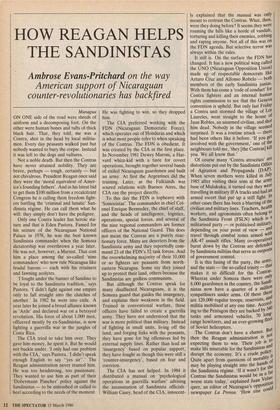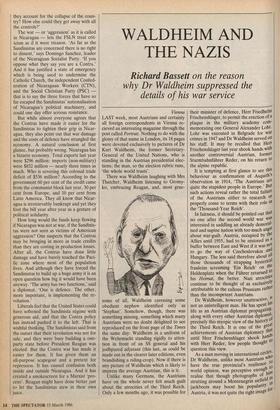HOW REAGAN HELPS THE SANDINISTAS
Ambrose Evans-Pritchard on the way
American support of Nicaraguan counter-revolutionaries has backfired
Managua
ON ONE side of the road were shreds of uniform and a decomposing foot. On the other were human bones and tufts of thick black hair. That, they told, me was a Contra, shot in the head by local militia- men. Every day peasants walked past but nobody wanted to bury the corpse. Instead it was left to the dogs and vultures.
Not a noble death. But then the Contras have never attained nobility. They are brave, perhaps — tough, certainly — but not chivalrous. President Reagan once said they were the 'moral equivalent of Amer- ica's founding fathers'. And in his latest bid to get them $100 million from a recalcitrant Congress he is calling them freedom fight- ers battling the 'criminal and lunatic' San- dinista regime. He can call them what he will: they simply don't have the pedigree.
Only one Contra leader has heroic sta- ture and that is Eden Pastora. Famed for his seizure of the Nicaraguan National Palace in 1978, he was the best known Sandinista commander when the Somoza dictatorship was overthrown a year later. He was not, however, a Marxist. That cost him a place among the so-called 'nine commanders' who now rule Nicaragua like feudal barons — each with his retainers and fawning acolytes.
'I fought under the banner of Sandino to be loyal to the Sandinista tradition,' says Pastora. 'I didn't fight against one empire only to fall straight into the clutches of another.' In 1982 he went into exile. A year later he joined a broad alliance known as 'Arde' and declared war on a betrayed revolution. His force of about 1,000 men, officered mostly by ex-Sandinistas, is now fighting a guerrilla war in the jungles of Costa Rica.
The CIA tried to take him over. They gave him money, he spent it. But he would not buckle under. 'I only had one problem with the CIA,' says Pastora, 'I didn't speak enough English to say "yes sir".' The Reagan administration never trusted him. He was too headstrong, too passionate. They wanted to use him as part of their Dobermann Pinscher' policy against the Sandinistas — to be unleashed or called to heel according to the needs of the moment. He was fighting to win, so they dropped him.
The CIA preferred working with the FDN (Nicaraguan Democratic Force), which operates out of Honduras and which is what most people refer to when speaking of the Contras. The FDN is obedient. It was created by the CIA in the first place. In November 1981 Dewey Maroni, a Har- vard whizz-kid with a taste for covert operations, brought together several bands of exiled Nicaraguan guardsmen and built an army. At first the Argentines did the training. Later, as the Falklands war soured relations with Buenos Aires, the CIA ran the project directly.
To this day the FDN is topheavy with `Somocistas'. The commander in chief Col- onel Enrique Bermudez, the chief of staff, and the heads of intelligence, logistics, operations, special forces, and several of the nine regional commanders are former officers of the National Guard. This does not mean the Contras are a purely reac- tionary force. Many are deserters from the Sandinista army and they reportedly com- mand 23 of the FDN's 52 task forces. And the overwhelming majority of their 10,000 or so fighters are peasants from north- eastern Nicaragua. Some say they joined up to protect their land, others because the Sandinistas are godless communists.
But although the Contras speak for many disaffected Nicaraguans, it is the Somoza guard that guides the insurgency, and explains their weakness in the field. Trained in conventional warfare, these officers have failed to create a guerrilla army. They have not understood that the war is more political than military. Instead of fighting in small units, living off the land, and forging links with the peasants, they have gone for big offensives fed by external supply lines. Rather than lead an 'insurgency' based on popular support, they have fought as though this were still a 'counter-insurgency', based on fear and coercion.
The CIA has not helped. In 1984 it distributed a manual on 'psychological operations in guerrilla warfare' advising the assassination of Sandinista officials. William Casey, head of the CIA, innocent- ly explained that the manual was only meant to restrain the Contras. What, then, were they doing before? It seems they were roaming the hills like a horde of vandals, torturing and killing their enemies, robbing and raping anyone. Not all of this was on the FDN agenda. But selective terror was always within the rules.
It still is. On the surface the FDN has changed. It has a new political wing called the UNO (Nicaraguan Opposition Union) made up of respectable democrats like Arturo Cruz and Alfonso Robelo — both members of the early Sandinista juntas. With them has come a 'code of conduct' for Contra fighters and an internal human rights commission to see that the Geneva convention is upheld. But only last Friday a Contra unit stormed the village of Las Laureles, went straight to the house of Juan Robles, an unarmed civilian, and shot him dead. Nobody in the village seemed surprised. It was a routine attack — there had been others like it before. 'If you get involved with the government,' one of the neighbours told me, 'they [the Contras] kill you. We all know that.'
Of course many 'Contra atrocities' are distortions put out by the Sandinista Office of Agitation and Propaganda (DAP). When seven mothers were killed in Jab' 1985 after visiting their sons at the wag base of Mulukuku, it turned out they were travelling in military IFA trucks and had an armed escort that put up a stiff fight. In other cases there has been a blurring of the civilian and military lines. Teachers, health workers, and agronomists often belong t° the Sandinista Front (FSLN) which is a militarised party — or politicised militarY, depending on your point of view — and travel through combat zones armed with AK-47 assault rifles. Many co-operatives burnt down by the Contras are defended by Sandinista militias that serve as outposts of government control. It is this fusing of the party, the aratY, and the state — the so-called trinity — that makes it so difficult for the Contras. Whereas under Somoza there were onlY 8,000 guardsmen in the country, the Sandi" nistas now have a quarter of a million sympathisers under arms. Of these there. are 120,000 regular troops, reservists, aiIT. militia mobilised at any one time. AerArAn° ing to the Pentagon they are backed by 3' tanks and armoured vehicles, 70 1008: range howitzers, and an ever-growing flee' of Soviet helicopters. n t The Contras don't have a chance. 'A. then the Reagan administration is no" expecting them to win. Their job ist°, make life miserable for the Sandinistas alw disrupt the economy. It's a crude polio': Quite apart from questions of moralitY tts may be playing straight into the hands ,_°_1 the Sandinista regime. 'If it wasn't for ta_c Contras the Sandinistas would be in a fa worse state today,' explained Juan V? o0 quez, an editor of Nicaragua's oppositw.iii newspaper La Prensa. 'How else coul° they account for the collapse of the coun- try? How else could they get away with all the controls?'
The war — or 'aggression' as it is called in Nicaragua — lets the FSLN treat crit- icism as if it were treason. 'As far as the Sandinistas are concerned there is no right to dissent,' says Domingo Sanchez, leader of the Nicaraguan Socialist Party. 'If you oppose what they say you are a Contra.' And it has justified a state of emergency which is being used to undermine the Catholic Church, the independent Confed- eration of Nicaraguan Workers (CTN), and the Social Christian Party (PSC) — that is to say the three forces that have so far escaped the Sandinistas' nationalisation of Nicaragua's political machinery, and could one day offer serious resistance.
But while almost everyone agrees that the Contras have made it easier for the Sandinistas to tighten their grip in Nicar- agua, they also point out that war damage and the costs of defence have strangled the economy. A natural conclusion at first glance, but probably wrong. Nicaragua has a bizarre economy. Total exports last year were $296 million: imports (non-military) were $832 million — nearly three times as much. Who is covering this colossal trade deficit of $536 million? According to the government 60 per cent of the credit came from the communist block last year, 30 per cent from Europe, and 10 per cent from Latin America. They all know that Nicar- agua is irretrievably bankrupt and yet they foot the bill year after year as a gesture of political solidarity.
How long would the funds keep flowing if Nicaragua was not at war, if the Sandinis- tas were not seen as victims of American aggression? One suspects that the Contras may be bringing in more in trade credits than they are costing in production losses. After all, the Contras have done little damage and have barely touched the Paci- fic zone where most of the population lives. And although they have forced the Sandinistas to build up a huge army it is an open question how big it would have been anyway. 'The army has two functions,' said a diplomat. 'One is defence. The other, more important, is implementing the re- volution.'
Liberals feel that the United States could have softened the Sandinista regime with generous aid, and that the Contra policy has instead pushed it to the left. That is wishful thinking. The Sandinistas said from the outset that their revolution was not for sale, and they were busy building a one- party state before President Reagan was elected. But the Contra war has made it easier for them. It has given them an all-purpose scapegoat and a pretext for repression. It has caused confusion both inside and outside Nicaragua. And it has created a smokescreen for a Marxist 'pro- ceso'. Reagan might have done better just to let the Sandinistas stew in their own juice.



















































 Previous page
Previous page